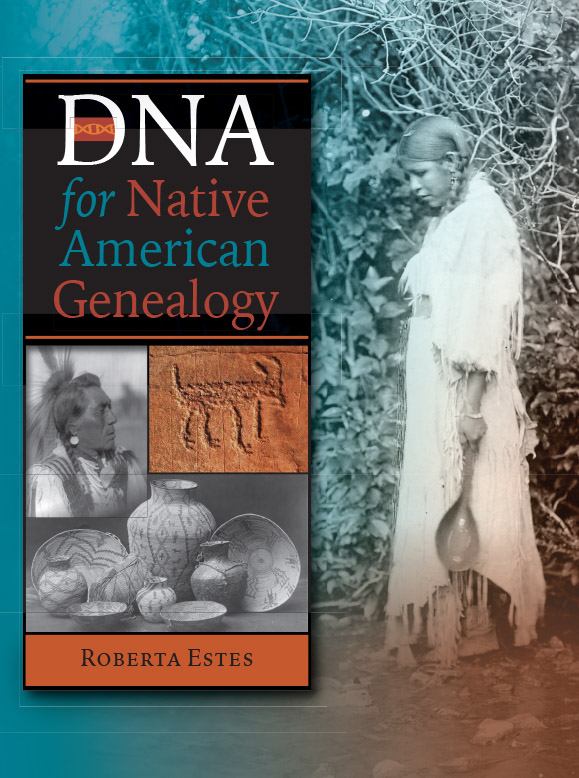Book Review: “DNA for Native American Genealogy”

When the esteemed Roberta Estes of the DNAeXplained Blog writes a book about DNA, there is a justifiable expectation that the work will be accurate, informative and definitive. Among Ms. Estes many accomplishments are launching the Million Mito Project and being a National Geographic Society Genographic Project affiliate scientific researcher. This is a very thoughtful book, intended to put actionable information in the hands of readers that will guide them through the process of learning about Native American genealogical research.
Determining Native American ancestry from DNA testing is not necessarily the easiest task. Ms. Estes takes the reader through comprehensive steps to examine how to work with ethnicity estimates, autosomal (atDNA) matching, mitochondrial (mtDNA) and Y DNA in identifying Native American DNA.
Part 1 is informative, containing an overview of the concept of tribal membership and asks readers to consider their goals for determining membership. Ms. Estes’ thoughts about cultural appropriation are well advised, and challenge each reader pursuing this research to think about the topic.
In Part 2 readers experience topics in ethnicity and population genetics. As both a professional scientist and genealogist the author is able to take readers as deep into genetic topics as they want to go. Her goal is for readers to understand the topics at a comfortable level, and she provides examples with clear illustrations.
Part 3 gives specifics about how to use the autosomal tools at major vendors in the search. The mitochondrial DNA portion of the book (Part 4) and the Y DNA portion of the book (Part 5) discuss the relevant ancient and modern haplogroups, sharing in detail which occur in Native American populations, and their tribal affiliations. These parts include maps of where the haplogroups are found. Part 6 is a roadmap and checklist which guides readers through the journey of investigating Native American ancestors through the use of DNA.
As with every book I review, I read this book from cover to cover. Given that my ancestors’ paper trails and our family’s genetic results show no indication of a Native American ancestor, a friend stepped in to help. His family history contains a story about an ancestor who was a member of a specific tribe, without any evidence. The story of this ancestor is currently unknown prior to a marriage that took place in Colonial America. He was willing to let me use his test results to see if any information could be found in his DNA that might potentially shed light on this family story, with his goal being genealogical information. The ancestor was not in his direct matrilineal or patrilineal line, so I turned to Part 3 of the book. Given how many generations back this ancestor had lived, the existence of identifiable regions of Native American DNA was doubtful. The history of the area suggests that the ancestor may have been a descendant of a tribal member rather than a tribal member, which lessened the chances of uncovering a segment.
My friend had tested on Ancestry, and then transferred his test results to FamilyTreeDNA, then had unlocked his autosomal transfer in order to use the ethnicity tools. First, I used the FamilyTree DNA myOrigins® (version 3) as shown in the book. As we had anticipated, his results showed 0% origin in the Americas. (His results also showed 0% Asian origins.) Opting in to Compare myOrigins® showed some interesting information for him to consider with his other matches. Part 3 also clearly walked me through the options within the Chromosome Painter to see a visual representation as well as how to view the locations of the chromosome segments. Next, the book took me through the features of using ethnicity information on Ancestry, with explanations about the Genetic Communities. Ancestry provided European matches, but no other traces of matching other parts of the world. Had Native American DNA segments been identified in my friend’s DNA, I would have known what to do next and how to do it. Although DNA may end up a part of the solution to my friend’s question about his ancestor, this family story will take more time and effort to prove or disprove.
Even though this particular case was not successful, there is clear value of this book to educate readers and guide them through identifying the appropriate steps they need to take to research known and potential Native American ancestors through the use of DNA.
This book picks up where the theories end and your work begins. The book contains references to source material, including Ms. Estes’ DNAeXplained blog, for those who want to go deeper into learning about the topics that are presented. For those who want to incorporate genetic genealogy into their Native American genealogical research, this book will be a complete introduction and will also serve as a reference during the research process. Readers will find the haplogroup references to be very useful in their research. The completeness of this book truly is, as Ms. Estes describes it, a labor of love.
The book is available at Genealogical.com and other booksellers.
This blog post is copyright ©2022 by Margaret M. McMahon, Teaching & Training Co., LLC. All rights reserved. No part of this post may be reproduced in any manner whatsoever without written permission, except in the case of brief quotations in articles and reviews. All copyrights and trademarks mentioned herein are the possession of their respective owners and the author makes no claims of ownership by mention of the products that contain these marks.



